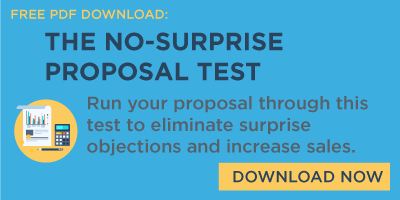 To sales managers and salespeople, "No" might be the worst word in the dictionary. Not only is it a buzzkill to hear the word, but it represents a terrible return on investment from the seller’s perspective.
To sales managers and salespeople, "No" might be the worst word in the dictionary. Not only is it a buzzkill to hear the word, but it represents a terrible return on investment from the seller’s perspective.Think about all the hours invested into these steps of the sales process:
- Identify
- Select
- Discover
- Advise
- Close
… just to hear "NO!"
What Happens When a Client or Prospect says NO? What’s Next?
After a quick trip to the bar for a double bourbon, I recommend a more strategic approach to figure out what happened and what to do about it. Think about these elements:1. Figure out why it is a "No."
- It could be something really simple. Start by asking what is causing the hesitation. Maybe you can revise and close right away by doing something as simple as changing the dates or dropping a complex piece of the solution and delivering the rest of the plan.
- If it’s not a simple issue you can work through immediately, determine how you can turn a no into a yes.
2. Turn a "No" into a "Yes."
To do this, you need to determine where the problem lies.
Here’s a deep dive into each:
Problems leading up to the proposal:
- Identify: Are you sure they are a good prospect? Is it possible they are not, but it took you this far into the sales process to figure that out? Go back to the Target Business Profile and determine if there is some key area (dollar potential, access, fit) where they don’t meet your criteria.
- Connect: Are you sure you connected with the Decision-Maker and Key Decision Influencers and involved them appropriately based on their decision-making process?
- Discover: Are you focused on a Desired Business Result that matters and determined 2-4 measures of success?
- Advise: Is the Solution strong, is everyone involved in the decision-making process bought in, and is it clear how it will deliver a strong return on investment?
Problems with your proposal:
Did you follow this recommended proposal template?
- Cover Page: Did you create a title focused on the desired business result. Remember to list all those you are presenting to and include your name, job title, contact information, and the date.
- Desired Business Result: Did you state clearly and succinctly the desired business result you and the prospect/customer have agreed to focus on.
- Measures of Success: Did you list the ways you and the prospect/customer have agreed you will measure success (we recommend 2-4 as a best practice).
- Tailored Solution: Did you present the solution in the context of how it will influence the consumer journey. Did you include other recommendations that are not included in your solution, but will benefit the customer, and increase the chances of success are added here.
- Critical Path: Did you use this closing and confidence building mechanism? While part of it is simply a list of all both parties have invested to this point, it is also evidence that you are thinking of the fulfillment plan going forward.
- Commitment: Did you include a sign-off page to ensure both parties are committed and that they feel the commitment of the other party. Did you use an expiration date to create urgency? Did you include language that communicates what it will be like doing business with you?
- Appendix: If you included all the sections above and in our recommended order, you should be able to present the right information in the right order, without getting in the weeds—and that makes it easier for the prospective buyer to follow. And that is why you want to put all the supporting details in the appendix.
Problems with presenting your proposal:
Here are the five (5) most common problems sellers encounter when presenting a proposal:
- Did you really ask for the business?
- Did you use mini-closes along the way to ensure you are focused on the right desired business result, that the prospect is in agreement with the measures of success, that they have a high degree of confidence in the solution, and that they are ready to proceed?
- Did you fail to identify and include all decision-influencers as part of the decision-making process?
- Did you miss important objections because you were not inviting that type of interaction before and during the presentation?
- Did you fail to adequately overcome the objections raised?
Fish or Cut Bait?
Next to "No," the following phrase is number two on the list of things I don’t want to hear, “Let me think about it.”
If you have kept in contact with the prospect and still don’t have an answer in 30 days, it’s probably dead. You may not need to walk away from the prospect, but it’s probably wise to walk away from this “opportunity” and try to re-engage the prospect with a new opportunity.
If you are going to re-engage, start over with a needs analysis. Be aware if anything may have changed: the timing, their desired business results, their sense of urgency, or something unique to the next opportunity.
If the "No" is a result of no cash, then it is time to move on from this prospect. Spending time with cash-poor prospects is a sure path to poor use of a seller’s time, and a lousy ROI!




